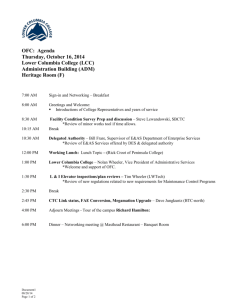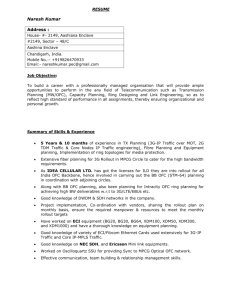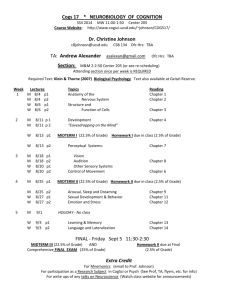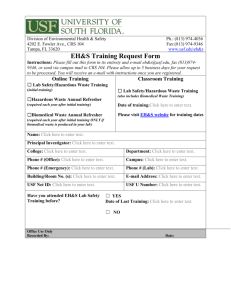Hurricane Preparation Manual
advertisement
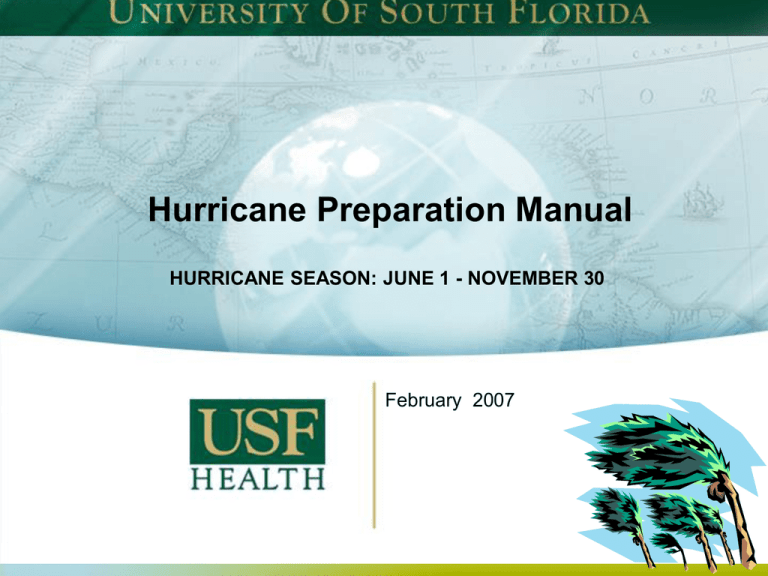
Hurricane Preparation Manual HURRICANE SEASON: JUNE 1 - NOVEMBER 30 February 2007 Table of Contents EMERGENCY RESPONSE TEAM OVERVIEW EMERGENCY COMMUNICATION TREE USF Health Emergency Response & Contact List ACTION STAGES FLOWCHART (Pre-Landfall Precautionary, Pre-Landfall Critical, Landfall, Post-Landfall) PREPARATION by ACTION STAGES for the following groups: Leadership/Communications Facilities Information Systems Clinical Operations Research Department Level Supervisor Faculty/Staff INDIVIDUAL PRECAUTIONS at HOME Supplies Check List Hurricane Resources EMERGENCY RESPONSE TEAM OVERVIEW Activation of Emergency Response • Only USF President, Judy Genshaft, can close the Tampa campus and the university. Notifications would be announced on www.usf.edu and on emergency phone line of 1-800-992-4231. • Only the Vice President for USF Health, Stephen Klasko, can close individual classes within the USF College of Medicine, College of Nursing, and College of Public Health. Cancellations of classes would be announced through the Dean’s Office of each college. • All Outpatient Centers (on and off campus) will close automatically, if USF President gives the order to shut down the USF campus. • USF-affiliated hospitals determine their own closings in time of crisis. USF physicians and residents with commitments to patients in those hospitals should work under the hospital plan of action. Hurricane & Disaster Management Updates during Crisis • Site with hurricane and disaster management information: • http://www.usf.edu/emergency_preparedness.asp • 800-992-4231 emergency hotline • WUSF Radio 89.7 FM news updates • Potential second website for emergency updates: www.health.usf.edu for UMSA/MSSC employees. Emergency Operation Team – periodically review emergency policies, formally meet every June and on a an hoc basis. In consultation with the Deans: • Clinical Operations – Peggy Madill • Communications (internal & external) – Michael Hoad • Computer data recovery - Jim McKenzie • Facilities – John Liston, Stanley Douglas, Rick Green • Financial Administration/IT – Joann Strobbe • Operations - Mohamad Kasti • Research Operations – Dr. Lynn Wecker • Residency Program Director – Dr. Peter Fabri • Student Services - Dr. Steve Specter • USFPG Business Operations - Joe Jackson • VP/Dean’s Office – Vicky Mastorides EMERGENCY INFORMATION FLOW Information Flow Executive decision to activate crisis plan is communicated via conference call (President, Carlucci, Klasko, Liston, etc.) Facilities Liston notifies: VP/Dean’s Office Chief of Staff notifies: Faculty/ Academics Curran Basic Science Chairs CON Phillips notifies: Research Rao notifies: Education Wallach Research Ops Facilities Wecker Douglas COPH Evans notifies: SOPT Hudson notifies: Hoad IT McKenzie notifies CFO Strobbe USFPG IT Fisher Communications VP/Dean’s Office Mastorides (back-up) State HR Wisgerhof USFPG Jackson notifies: Asst CIO Fernandes USFH IT Network Services Ovigwho Support Services Robinson Clinical Chairs Clinical Affairs Belsole notifies: USFPG Directors Clinical Ops Madill GME Fabri USF Health Emergency Response & Contact List USF Health – Emergency Contact list Belsole, Robert Ofc.974-6896 Burns, Pat Ofc.974-9207 Curran, John Ofc.974-1334 Names are in alphabetical order - standard protocol Douglas, Stanley Ofc. among police, fire and emergency responders. Engelman, Robert Ofc.745-6852 Area codes are 813 unless otherwise noted. Evans, Jay Ofc.9748412 This phone list with cell & home numbers is not for Fabri, Peter Ofc.974-9744 distribution beyond the leadership. Fernandes, Sidney Ofc.974-7927 Green, Rick Ofc.974-4594 Haynie, Pat Ofc.974-4951 Hoad, Michael Ofc.974-3300 USF Health Housestaff Coordination Jackson, Joe Ofc.974-8420 Kasti, Mohamad Ofc.974-3674 Fabri, Peter (satellite phone) Klasko, Stephen Ofc.974-6894 Liston, John Ofc.974-3017 Luth, Terry Ofc.974-8175 University Relations emergency contact list Mastorides, Vicky Ofc.974-3388 **USF Campus Police 974-2628 McKenzie, Jim Ofc.974-7555/974-2945 **USF President’s Office 974-2791/Lifsey House 974-1094 Ovigwho, Godfrey Ofc.974-6617 Betancourt, Kathy Ofc.974-2660 Petersen, Donna Ofc.974-2157/974-6603 Carlucci, Carl Ofc.974-3297/974-7220 Phillips, Anne Ofc.974-2191 Longo, Tom (Campus Police Chief) Ofc.974-2972 Rao, Abdul Ofc.974-5200/396-9172 Meninghall, Jennifer Ofc.974-9084 Robinson, Alison Ofc.974-4969 Visot, Cindy Ofc.974-1678/974-6465 Strobbe, Joann Ofc.974-4210/974-4991 Wade, Lara Ofc.974-9060/974-1498 Wallach, Paul Ofc.974-2423 Wecker, Lynn Ofc.974-3823 Wisgerhof, Nancy Ofc.974-3595 ACTION STAGES FLOWCHART For: Leadership/Communications Facilities Information Systems Clinical Operations Research Department Level Supervisor Faculty/Staff Pre-Landfall Precautionary Within 2-5 Days STAGE 1 Does President announce closing of campus? Yes Yes Pre-Landfall Critical Within 1 Day STAGE 2 Is impact imminent? Landfall STAGE 3 Does President reopen campus? Yes Post-Landfall STAGE 4 LEADERSHIP/COMMUNICATIONS Preparation Stage 1. Pre-landfall Precautionary (within 2-5 days) - AVP Public Affairs reviews USFH event for rescheduling - AVP Public Affairs verifies availability of essential personnel phone #'s and provide to main campus - AVP Public Affairs directs students/employees to USF Homepage, 800#, and WUSF for updates - Facilities Director attends teleconference with main campus - Liston updates USFH EOT (as needed) Stage 2. Pre-landfall Critical (within 1 day) - AVP Public Affairs announces cancellation of classes via email and Blackboard - Departments request employees to secure, move, shut-down equipment - Facilities Director attends teleconference with main campus - Liston starts EOT operations - Departments release non-essential employees Stage 3. Landfall - USFH EOT communicates with main campus through alternative means Stage 4. Post-Landfall - AVP Public Affairs emails opening to employees - AVP Public Affairs emails opening to students - AVP Public Affairs ensures media aware of Clinic opening - Liston ends EOT operations - Facilities Director attends teleconference with main campus FACILITES Preparation Stage 1. Pre-landfall Precautionary (within 2-5 days) - Facilities Director identifies inventory to be secured - Facilities Director identifies capacity of emergency circuits Stage 2. Pre-landfall Critical (within 1 day) - Facilities Director secures buildings after evacuation - Facilities Director ensures construction sites are secured, tied down, and cleaned up - Facilities Director provides card access for essential personnel - Facilities Director provides Physical Plant support Stage 3. Landfall - USF Police ensure buildings secure Stage 4. Post-Landfall - Facilities Director assesses damage/theft - Facilities Director assess safety hazards - Facilities Director activates card access INFORMATION SYSTEMS Preparation Stage 1. Pre-landfall Precautionary (within 2-5 days) - IT emails data protection tips to employees and students - IT identifies data to be backed up Stage 2. Pre-landfall Critical (within 1 day) - IT backs-up data - IT protects Servers - Faculty/Staff place their PC’s and IT equipment on a raised surface Stage 3. Landfall Stage 4. Post-Landfall - IT begins data recovery - IT begins website recovery - IT informs AVP Public Affairs when it is safe for faculty/staff to plug IT equipment back in CLINICAL OPERATIONS Preparation Stage 1. Pre-landfall Precautionary (within 2-5 days) - Director, Patient Care exports list of patients scheduled during possible impact days to Televox system within 36 hrs - VP, Clinical Affairs reminds Chairs to follow hospital policy and provides his contact information for further questions Stage 2. Pre-landfall Critical (within 1 day) - Director, Patient Care coordinates announcement of Clinic Closing to patients via Televox or staff call scheduling list - Dr. Fabri communicates with residents via pages/texts Stage 3. Landfall - Providers/residents follow the emergency plan of the hospital that they are assigned to at the time Stage 4. Post-Landfall - Departments open clinic RESEARCH Preparation Stage 1. Pre-landfall Precautionary (within 2-5 days) - Facilities Manager identifies essential lab personnel to have card access or official escort during campus closing - Departments prioritize critical reagents and specimens for cryostorage to be placed on emergency circuits Stage 2. Pre-landfall Critical (within 1 day) - Essential lab personnel maintain sensitive research needs Stage 3. Landfall Stage 4. Post-Landfall - Research personnel assist with rescue and recovery DEPARTMENT LEVEL SUPERVISOR Preparation Stage 0. To Be Done Routinely 1. Keep the Individual Unit Plan available in appropriate locations. Distribute the Unit Plan to all personnel (especially new hires) and periodically review it to ensure that the staff is familiar with its contents. 2. Appoint an alternate who will be responsible in your absence or if people cannot contact you. 3. Review the Individual Unit Plan annually, updating as necessary any of the following: a. Names, addresses, and telephone numbers of all personnel, consultants, services, etc. b. Names of personnel assigned specific duties. c. Emergency procedures. d. Location of supply rooms and local stores. e. Floor plans. f. Insurance coverage and physical inventory (take pictures or videotape all facilities and equipment). Maintain a written list of equipment. 4. Designate critical personnel to stay on campus during a disaster and/or to report back as soon as possible after a disaster. 5. Make arrangements for appropriate remote storage of critical computer disks, back-up files, and archival records. 6. Identify and inspect several times a year all areas and equipment which may cause or be subject to a disaster. These will include: a. Wiring systems. b. Electrical appliances, such as ovens. c. Plumbing and air conditioning units. d. Telephones. 7. Inspect on a regular basis the following safety equipment: a. All types of fire extinguishers. b. Fire alarm system. c. Sprinklers. d. Smoke and heat detectors. e. Security alarms. 8. Update the supply inventory yearly, noting in particular the supplies on hand and those which would have to be purchased in an emergency. Supplies on hand should include the following: a. Plastic and tape to protect electronic equipment. b. Emergency safety supplies. c. Materials to protect the facility and contents. d. Materials for post-disaster cleanup. DEPARTMENT LEVEL SUPERVISOR Preparation Stage 1. Pre-landfall Precautionary (within 2-5 days) 1. 2. 3. 4. 5. 6. 7. 8. 9. Notify employees who report to you of impending disaster and remind them of what is required for event preparation before the storm and steps of "Business Continuity Plan". Designate contacts whose primary job would be to facilitate communication with key staff and to serve as contact for all staff to report in immediately after a disaster. Contacts would also determine any critical needs of disaster victims and offer assistance. Ensure that the "General Contact Telephone Number(s) for Your Unit/School" are known and that all employees know who their designee contact is, and have the contact telephone number(s) (including home numbers) once a disaster is over in order that the status of employees be communicated to University administration and that any special needs of employees can be determined. Review Disaster Recovery Plan and distribute a copy of "individual action" section to each employee. Provide materials to copy data secured on computer disks. Perform a special backup of computer files -- instruct employees to take floppy disks home with them. Contact vendors under assistance agreement and make appropriate support arrangements. Ensure University vehicles are fully fueled. Provide each employee with a list of everyone's address (if possible, attach map to show location) and phone number (home, cellular, emergency contact person), and evacuation location (if relevant). Take home cellular phone and/or 2-way radio (if appropriate) after fully charging batteries for all communication devices. DEPARTMENT LEVEL SUPERVISOR Preparation Stage 2. Pre-landfall Critical (within 1 day) 1. Ensure individual actions have been satisfactorily completed; assist everyone with vacating the facility as soon as possible and do a final walk-through of your area before leaving. 2. Contact your immediate supervisor with an update on status of employees who report to you. 3. During non-business hours (i.e., weekend or holiday) contact employees to return to work in order to assist in preparing their offices for the disaster. FACULTY/STAFF Preparation Stage 1. Pre-landfall Precautionary (within 2-5 days) 1. Review your individual Unit Plan with your supervisor. 2. Back-up critical files and store them in an off-site location. FACULTY/STAFF Preparation Stage 2. Pre-landfall Critical (within 1 day) 1. 2. 3. 4. 5. 6. 7. Turn off (preferably disconnect) all electrical equipment including typewriters, computers, lights, window air conditioners, microwaves, etc. Refrigerators should be left on at the coldest setting and covered with a blanket, if available. If practical, move desks, file cabinets and equipment away from windows and off the floor; store as much equipment as possible in closets or in windowless rooms away from external walls. Clear desk tops completely of paper and other articles. Protect books and equipment by covering with plastic sheeting and using masking tape to secure. Remove any food and perishable supplies. Provide for the necessary care and feeding of all animals, where applicable. In locations where flooding is a possibility, to the extent practical, relocate critical equipment from the ground floor to a higher floor or a higher off-site location. Remove all loose items (garbage receptacles, chairs, tables, plants, etc.) from outside of buildings. Remove all items from window ledges. Lock all file cabinets and desk drawers. Lock and secure all doors and windows. INDIVIDUAL PRECAUTIONS at HOME Stay away from low-lying beaches or other locations, which may be swept by high tides or storm waves. Leave those areas early because roads to safe locations may become impassable several hours prior to the arrival of hurricane conditions. Stay home if your house is safe from high water and flash flooding. Bring in everything that could blow away - garbage cans, garden tools, furniture and plants. Remove limbs from trees that may damage your house or utility wires. Remove ripe coconuts from palm trees. Secure garage doors. Awnings which can be moved should be raised and tied securely or taken down. Fasten storm shutters or board up windows with good lumber. Do not drain your swimming pool. Turn off all electrical power to the pool and remove all loose items from the area. Have several flashlights in good working condition. Be careful of fire. Have a bucket of sand or good fire extinguisher available to put out fires. Be sure you have sufficient food on hand that does not need refrigeration or cooking. Fill clean containers with drinking water; allow 1 gallon per person per day. Your water heater, bathtub and washing machine can all store several gallons of fresh water to use for sanitation and washing. Keep radio on. Battery-powered radio is a must in case of power failure. Supplies Check List at Home Cash Map of the area with landmarks on it Bleach or water purification tablets Extra batteries (include hearing aid) First Aid Kit, including aspirin, bandages, antibiotic cream Mosquito repellant & sunscreen (SPF 45 recommended) Ice chest and ice Battery-powered radio, alarm clock, flashlights (1 flashlight per person) Waterproof matches/butane lighter Camp stove or grill with fuel and/or charcoal & lighter fluid Manual can opener Canned and dry food and drinks Disposable plates, cups, utensils, napkins & paper towels Large trash bags (lots of them) Special supplies for babies and/or pets Hurricane Resources • Agricultural and Consumer Services Price Gouging Hotline.....800-435-7352 • American Red Cross Food/Shelter/Financial Assistance.....866-438-4636 • Attorney General’s Price Gouging Hotline.....800-646-0444 • Federal Emergency Management Agency (FEMA)....800-621-3362 • Florida Power & Light Outage Dept.....800-468-8243 • Salvation Army Donation Helpline.....800-725-2769 • State Volunteer and Donations Hotline.....800-354-3571 • Tampa Electric (TECO) Outage Dept.....1-877-588-1010 National Hurricane Center: www.nhc.noaa.gov Hurricane Categories WINDS STORM SURGE Category 5: Catastrophic 156+ mph 20-24 ft Category 4: Extreme 131-155 mph 15-20 ft Category 3: Extensive 111-130 mph 12-15 ft Category 2: Moderate 96-110 mph 7-12 ft Category 1: Minimal 74-95 mph 5-7 ft Tropical Storm: Minor 39-73 mph 3-5 ft


